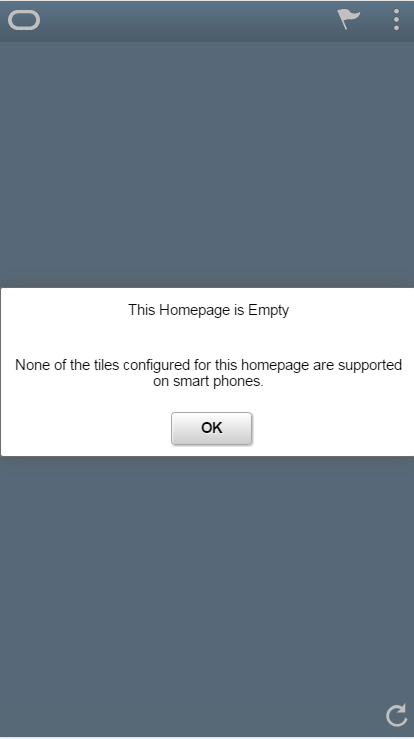Working with Fluid Homepages and Dashboards
This topic contains an overview and introduces the concepts involved with using fluid homepages and dashboards.
A fluid homepage is the fluid equivalent of a classic homepage. A fluid homepage is a PeopleSoft page that aggregates related information and displays tiles that can provide both snapshots of actionable information as well as navigation to fluid applications. Tiles can be compared to pagelets used in classic homepages.
A fluid homepage and the tiles it displays typically share a common purpose or apply to a specific role, such as employee, manager, clerk, and so on. When working with tiles on a homepage, you can select the tile to access the underlying application and perform routine tasks. Tiles typically have a graphic on them, portraying the purpose of the underlying application, which helps you to identify them and associate the tile with the application. Some tiles also display current information, making you aware of high-level information for decision making or monitoring.
Image: Example of a fluid homepage displaying tiles
This example illustrates the appearance of a fluid homepage with a number of tiles that you can select (press or tap) to view information or complete a task. For descriptions of the elements and usage of the homepage, see Working with Fluid Homepage Controls.
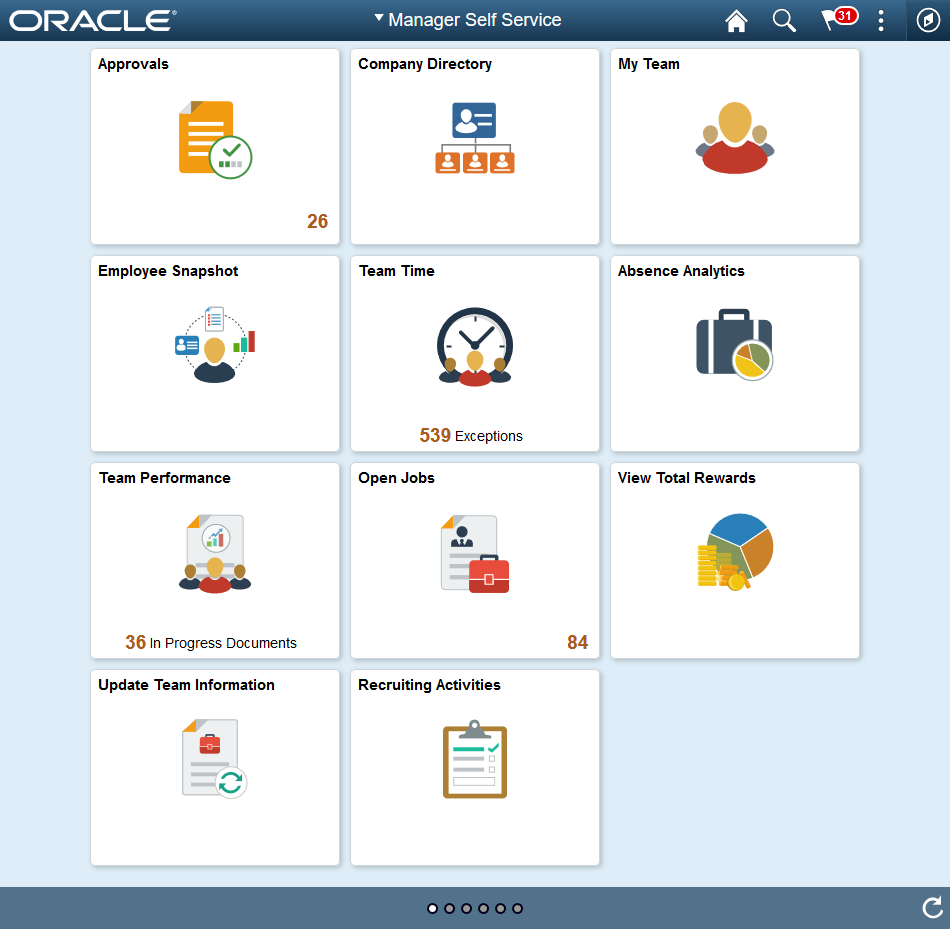
A fluid dashboard is the fluid equivalent of a classic dashboard. Similar to classic dashboards, fluid dashboards do not appear automatically after sign in; instead, you access a fluid dashboard by clicking a content reference link, which can be configured to appear anywhere in the menu structure. Similar to a fluid homepage, a fluid dashboard aggregates related information and displays tiles that can provide both snapshots of actionable information as well as navigation to fluid applications. A fluid dashboard and the tiles it displays typically share a common purpose or apply to a specific role, such as employee, manager, clerk, and so on. While you can personalize a fluid dashboard, you can add only those tiles that have been configured for use on the dashboard by the dashboard administrator.
Image: Example of a fluid dashboard
This example illustrates the appearance of a fluid dashboard. For descriptions of the usage of the controls in the fluid banner at the top of the dashboard, see Working with Fluid Homepage Controls and Using the Back Button.

The following list describes the controls that appear on fluid homepages and fluid dashboards.
|
Field or Control |
Definition |
|---|---|
 |
Branding logo (optional). Note: Displayed on fluid homepages only, and not on fluid dashboards. |
 |
Homepage drop-down selector. When there are multiple homepages to which users have access, they switch to other fluid homepages using this drop-down list. Note: Displayed on fluid homepages only; fluid dashboards display the page title of the dashboard. |
 |
Home button. Use to return to your default homepage, which is the homepage that you arrive at immediately upon signon. |
 |
Search button. Use to perform global searches. See Working with Global Search. |
 |
Notifications button (without a numeric badge). Use to display the Notification window showing any pending actions or alerts. See Using the Notification Window. |
 |
Actions button. Use to display the Actions menu. See Using the Actions Menu. |
 |
NavBar button. Use to display the navigation bar (NavBar). See Working with the NavBar. |
 |
Homepage indicator. When there are multiple homepages to which you have access, the homepage indicator shows the total number of available homepages, represented by a small circle. The current homepage’s position in the sequence of homepages is represented by a white circle, while the remaining fluid homepages in the sequence are represented by grey circles. Note: The homepage indicator is not a navigational control. As in, you cannot click on a circle to display the homepage it represents. The homepage indicator only displays orientation information. This indicator is displayed on fluid homepages only, and not on fluid dashboards. |
 |
Refresh button. Use to refresh, redraw, re-render the fluid homepage, manually, so that all live tiles display the most current representation of the underlying data if you’ve been on the homepage for a period of time. Individual tiles can be configured to refresh at specific rates. |
This section discusses these topics:
Accessing the personalize page.
Adding a fluid homepage.
Deleting a fluid homepage.
Accessing the Personalize Page
To manage fluid homepages, you need to access the Personalize page.
To access the Personalize page:
Navigate to any fluid homepage.
Select the Action menu.
Select Personalize.
Image: Personalize page
This example illustrates the options on the Personalize page, used for personalizing the content on a fluid homepage. Descriptions of the options and controls appear after the example.
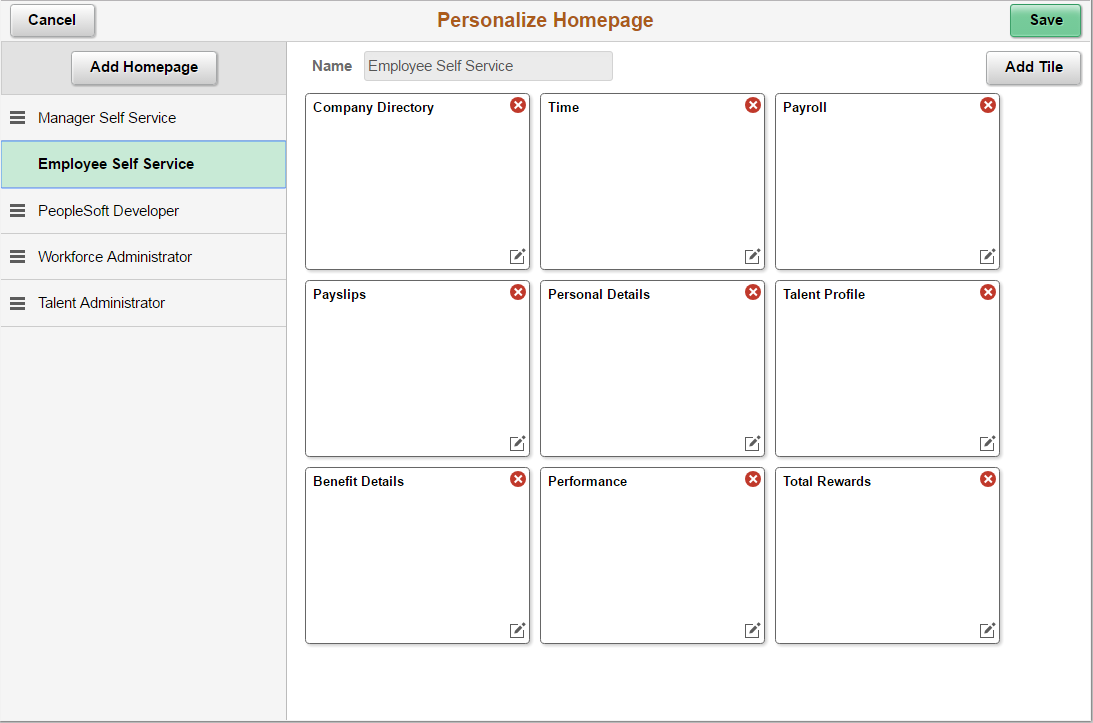
Note: The labels of system-defined homepages and dashboards are translatable; however, personalized labels of homepages and dashboards are not translatable—this applies to personal fluid homepages as well as the personalized labels of fluid homepages, fluid dashboards, classic homepages and classic dashboards.
Adding a Fluid Homepage
To add a homepage:
On the Personalize page, press the Add Homepage button.
In the Add your own edit box, enter the name of the new homepage, and click Add.
Note: The system imposes a limit of 10 user-defined homepages.
In the left column of the Personalize page, click the cell reflecting the name of your new homepage.
At the top of the page in the title box, modify the homepage title, if needed.
Press the Add Tile button.
In the Add Tile dialog box, navigate to the fluid page to be the target of the tile.
Note: The Add Tiles dialog box only displays tiles sub-folders under the Fluid Pages folder (Structure & Content, Fluid Pages). In a clustered environment, it shows tiles found on remote content provider databases as well (universal navigation).
Repeat steps 5-6 as needed until the required tiles appear on the homepage.
Deleting a Fluid Homepage
To delete a homepage:
On the Personalize page, locate the homepage in the left-hand column.
Press the red, circular icon with an ‘x’ in it.
Press Save on the Personalize header.
This section contains an overview and discusses:
Adding tiles.
Adding ad hoc tiles to fluid homepages.
Deleting tiles.
Copying tiles to other fluid homepages.
Moving tiles to other fluid homepages.
Dragging and dropping tiles.
Understanding Tiles
Tiles can be compared to pagelets, which are added to portal homepages in the existing portal technology or PeopleSoft Interaction Hub. In the fluid user interface, you add tiles to homepages.
Tiles enable you to:
Aggregate and display content.
Provide quick access to targeted transactions.
When working with tiles, consider:
Any number of tiles can be added to a homepage.
Tiles that do not fit within the current view appear as “peeking” tiles at the bottom of the screen.
You can modify the number of tiles on a homepage or the position of tiles while accessing it, but only in personalization mode.
An administrator can assign tiles to a homepage through Structure and Content, however positioning cannot be modified through Structure and Content.
Tiles can be used to link to fluid applications or classic applications.
Adding Tiles
To add tiles to a fluid homepage or dashboard:
Navigate directly to the desired fluid homepage or dashboard.
Note: You can personalize a fluid dashboard only after navigating directly to the dashboard; it cannot be personalized when displayed inside an activity guide, fluid navigation collection, or master/detail wrapper.
From the Actions menu, select Personalize.
In personalization mode, press Add Tile.
Find the desired transaction in the Add Tile dialog box. You have these options:
Enter the name or partial name of the content reference in the search box, and click the Search button.
Manually navigate through the folders to select the desired content reference.
Select the tile to be added.
Press Save on the Personalize page.
Image: Add Tile dialog box
This example illustrates the Add Tile dialog box, which you use to complete the procedure above.

|
Field or Control |
Definition |
|---|---|
 |
Indicates that a tile will display on a homepage accessed from a smart phone. If this icon does not appear next to a tile, you will not be able to see the tile when accessing the homepage using a smart phone. You will see the tile on other devices, such as a tablet, laptop computer, or desktop computer. In the example above, Personal Details would not appear on the homepage if accessed using a smart phone. |
Adding Ad Hoc Tiles to Fluid Homepages
You can also add ad hoc tiles to fluid homepages using the Add To Homepage link in the Actions menu. No actual tile definition will be created for ad hoc tiles. The information is stored in the system as personalization data only.
Image: Add To Homepage dialog box
When you add an ad hoc tile to a fluid homepage, you can edit and personalize the label for the item. For example:

Deleting Tiles
To delete tiles from a fluid homepage or dashboard:
Navigate to the desired fluid homepage or dashboard.
From the Action menu, select Personalize.
Locate the tile you want to delete from the homepage.
Press the red circle containing a white X.
Press Save on the Personalize page.
Copying Tiles to Other Fluid Homepages
To copy tiles to other fluid homepages:
Navigate to the desired source homepage.
From the Action menu, select Personalize.
Locate the tile you want to copy from the homepage.
Press the Action button in the bottom, right-hand corner of the tile.
On the Select Action prompt, select Copy.
On the Copy To prompt, select the desired target homepage.
Press Save on the Personalize page
Moving Tiles to Other Fluid Homepages
To move tiles from one homepage to another:
Navigate to the desired source homepage.
From the Action menu, select Personalize.
Locate the tile you want to move from the homepage.
Note: Moving a tile removes it from the source so that it only appears on the target homepage. To have the tile exist on both homepages, use the Copy tile action.
Press the Action button in the bottom, right-hand corner of the tile.
On the Select Action prompt, select Move.
On the Move To prompt, select the desired target homepage.
Press Save on the Personalize page.
Dragging and Dropping Tiles
To drag and drop tiles to reposition on a fluid homepage or dashboard:
Navigate to the desired fluid homepage or dashboard.
Note: You can drag and drop to reposition tiles in either regular mode or personalization mode.
Press on the tile you want to reposition on the homepage or dashboard, drag it to the desired location, and drop the tile by releasing it.
Note: You must drop a tile onto another tile for the tile to be repositioned. Dropping the tile into empty space will not trigger the drag and drop feature.
To drag and drop tiles to a different fluid homepage:
Navigate to the desired homepage.
From the Action menu, select Personalize.
Press on the tile you want to move to a different homepage.
Drag the tile and hover it over the desired homepage in the left-hand column, where each homepage is listed.
When the desired homepage becomes active, release the tile.
Press Save.
Not all tiles appear on fluid homepages or dashboards when accessed by small form factor devices such as smart phones. If the application a tile opens would not be suitable to be displayed on a smaller device, such as on a smart phone, your system administrators may restrict that tile from appearing on the homepage or dashboard when you access the system on your phone. From the Personalize page, you can determine the tiles that will not display on a smart phone by looking for the following message on the tile:
Tile is not supported on this device
Image: Personalize page on a smart phone
This example illustrates the Personalize page when accessed by a smart phone. Note that the system is indicating that the Personal Details tile will not display on the homepage when accessed by a smart phone.
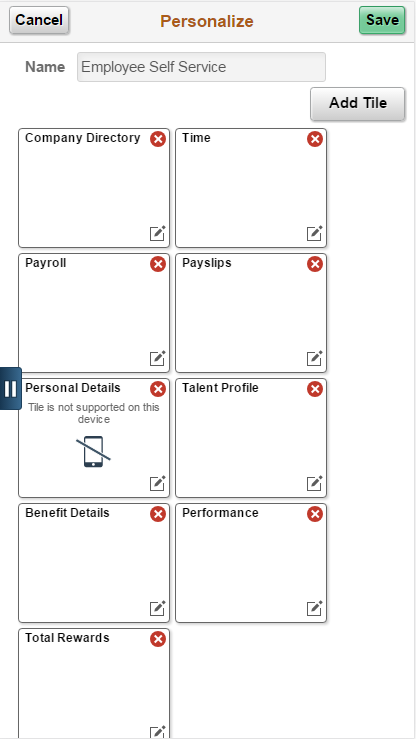
Image: Fluid homepage accessed from a smart phone
This example illustrates that the Personal Details tile does not appear on the fluid homepage for a smart phone as indicated by the message on the tile in the previous example.
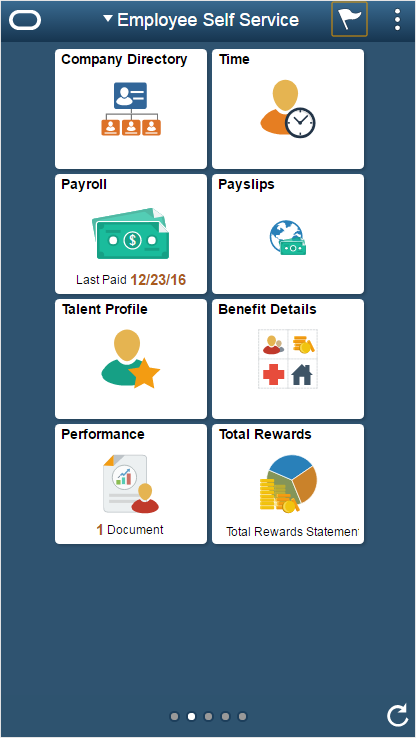
If a homepage contains no tiles that are configured to display on a homepage for smart phones, the homepage will be empty and display an informational message.
Image: Empty fluid homepage displaying a message for smart phones
If you access a fluid homepage using a smart phone, and none of the tiles on that homepage are supported for use on a small device, such as a smart phone, the system displays an informational message letting you know why the page is empty.
